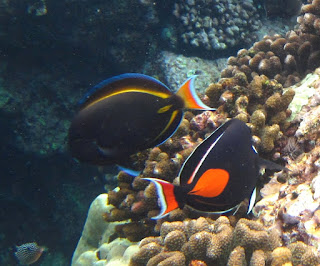 |
| Pinkerton Avocados Growing On Our Tree |
All of our fruit trees have responded to the lengthening days...what's that got to do with the goings on down at the beach? Well, its still winter back in the PNW and so on our beaches we still have a few ladylike tourists wearing bikinis. A delightful few weigh in under 12 stone. Meanwhile in the sea, we are noticing a congregation of halfbeaks. It struck me as more than coincidental that many of my previous pictures of halfbeaks were taken in Februaries past. Is early spring a time when this fish approaches the shore in increased numbers?
You may recall the previous blog where we discussed the beautiful blue halfbeaks seen at Ho'okena. It is my pleasure to announce that Jack Randall, the dean of Reef Fish Biology on the planet, believes that these are Acute Halfbeaks. My first sighting of this species. In my query to Dr Randall he replied:
Thank you for your remarkable photo of a group of halfbeaks. I agree with you that they seem to be the Acute Halfbeak. I did not know they could be such a bright blue. I will e-mail your photo to Dr. Bruce Collette at the Smithsonian Institution. He is the world authority on halfbeaks and needlefishes.
 |
| Dr. Collette Engaging a Halfbeak |
Like Dr. Randall, Dr. Collette is an ichthyologist. When push comes to shove, they do not identify fish the same way you and I do. We look for field marks, they count scales and dorsal fin spines. Suffice it to say, if Jack Randall had one of those blue beauties from Ho'okena in his lab, he wouldn't have to guess what it was. The scale count would tell the tale. And of course, after counting the scales he would take the fish back to the bay, release it and it would swim merrily away with its buddies. Not! (Note to halfbeaks...steer clear of Drs. Collette and Randall.)
Well, John Hoover, who, being a hobbyist, identifies fish like we do, wasn't quite so sure. With this lingering doubt in mind, I felt fortunate, indeed, when swimming yesterday at the pier, I was presented with a school of halfbeaks in clear water. They were fairly cooperative and one of my many shots was quite good.
 |
| Polynesian Halfbeak Kailua Pier 2/19/13 |
In the fish seen at Ho'okena, pictured below, the bill is perfectly straight with the line of the body. This was seen in all the fishes of that school.
 |
| Acute Halfbeak, Hookena Feb 2013 |
I'll let you know if there is any word from the experts on this fieldmark. In the meantime, I'm leaving you with a lovely picture of a Threadfin Butterfly taken
 |
| Threadfin Butterlyfish, Kahalu'u, Feb 3013 |
jeff
















